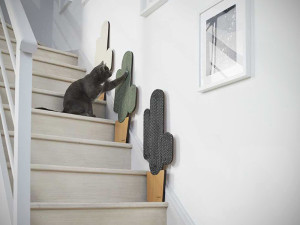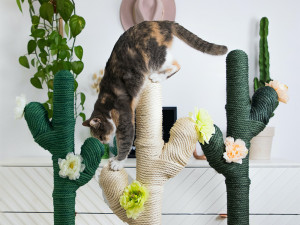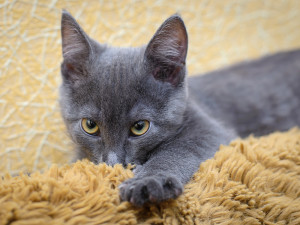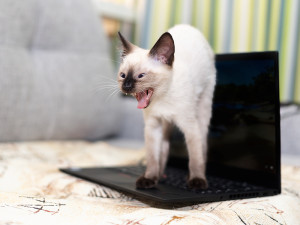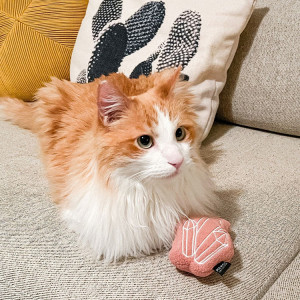How to Stop Your Cat From Absolutely Ripping Apart Your Couch
Placing a cat tree or post in a room only, uh, scratches the surface of solving this problem.
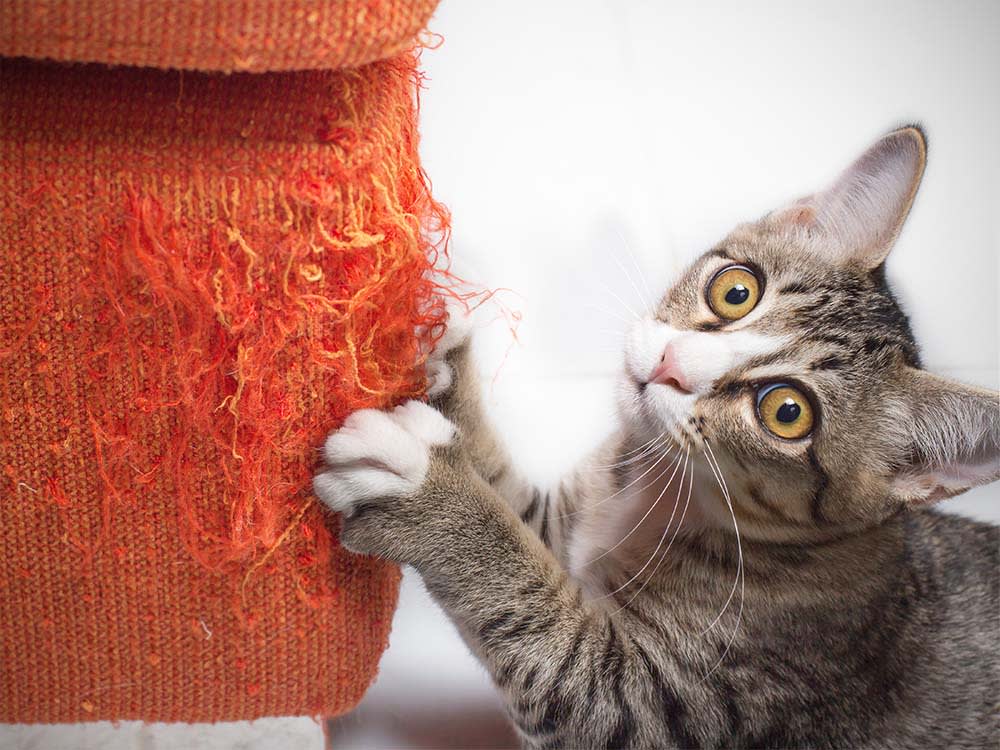
share article

Your pet wants you to read our newsletter. (Then give them a treat.)
Feeling like your cat has a vendetta against your couch? As much as we all love our cats — and their adorable toe beans — we can all likely agree that we could do without them leaving their mark on our beloved couches, chairs, carpets and rugs, mattresses, door frames, and whatever else they manage to sink their claws into.
Here’s what makes cats scratch furniture and how to save your couches and chairs from their sharp little shredders — er, cute little paws.
Why Cats Scratch Furniture
It can feel like your cat has it out for you and the furniture you carefully saved for and/or paid off over time, but trust us, that’s not what’s going on. Cats scratch things because it’s a natural behavior that keeps their claws healthy, claims their space, and lets them stretch their muscles. In nature, they’d use a tree, but it appears that your furniture is the next best thing.
These are the top reasons why cats need to scratch, according to Stephen Quandt, a certified cat behavior specialist and founder of Cat Behavior Helpopens in a new tab:
It Feels Good
Just like a good sun salutation, the feeling of sinking their nails into something and dragging them feels downright good.
Nail Maintenance
Cats have protective nail sheaths which are crescent-shaped, opaque coverings at the end of each claw protecting nails from damage. As cats scratch, they shed old nail sheaths and new ones grow in their place. Besides shedding bothersome sheaths, scratching also prevents overgrown and ingrown nails.
Communication With Other Cats
“Cats have scent glands all over their bodies including in their paws,” Quandt says. When they scratch something, they leave their scent behind to tell other cats that they were there and when. Even if there’s no other cat around to detect it, cats still mark their territory because it’s in their nature.
Positive Reinforcement
Quandt says cats scratch objects because they know it gets their humans’ attention. For instance, your cat is hungry, and you’re late serving dinner. So, they scratch the couch. You might initially direct your attention to them to stop the behavior, then quickly feed them. Therefore, your cat learns that scratching means attention and faster meal service.
How to Stop Cats From Scratching Furniture
As much as we may want to deny it, scratching is an innate and necessary activity for cats. The key to stopping cats from scratching furniture is to redirect their scratching to appropriate surfaces, Quandt says. Just placing a cat tree in a roomopens in a new tab won’t cut it, he adds. Training cats to “scratch this, not that” requires a behavioral plan — but we promise it’s more straightforward than it sounds.
Give them what they want
Not all cat trees and scratching surfacesopens in a new tab are made the same. Before impulse-buying the first cat tree you see, take note of the surfaces your cat tends to scratch. Quandt says cats like to scratch in different ways. Some like to scratch vertical surfaces while others like flat, horizontal ones. They also like different materials to scratch on. Some cats may like carpet, while others prefer rope, and our wild-at-heart felines might prefer scratching on soft wood. “We have to give them what they like,” he says.
Use pheromones
Cats scratch the same couch and spot over and over because that’s where their scent is. According to Quandt — and a studyopens in a new tab documenting a 74 percent success rate — pheromones can be an effective addition to your behavioral plan.
Cat pheromone sprays and diffusersopens in a new tab mimic cats’ social pheromones when rubbing against or scratching objects. So, using pheromone sprays and diffusers on or near furniture reduces a cat’s urge to return to the furniture and re-apply their scent. Spray them twice a day when teaching your cat not to scratch furniture, Quandt says. Once the scratching stops, there’s no need to reapply unless there’s a scratching relapse.
Create new positive associations
With a toy, play with your catopens in a new tab at the scratching post or pad. When they attack and sink their nails into the surface, immediately give them a treatopens in a new tab and/or praise them with pets or verbally. Once your cat learns that the post is a fun and rewarding place, you can reinforce the behavior using intermittent reinforcement. This means you won’t reward your cat after every scratch, but rather randomly — kind of like a Vegas slot machine, Quandt says.
At the same time, make your furniture unappealing with double-sided sticky tape. When combined with pheromones, your cat will soon learn that there are more rewarding objects to tear into.
Positive reinforcement, not punishment
Cats don’t understand punishment and, yes, this includes squirting a cat with water. Rather than stopping unwanted behaviors, such as scratching furniture, punishing cats can majorly backfire. It creates a more stressful living environment for your sensitive kitty, which can actually lead to more fear and anxiety-induced destructive behaviors, redirected aggression, and an overall damaged relationship with your cat. It’s a lose-lose for everyone.
Other Things to Keep in Mind
Good news: From day one of being a proud cat parent, you can prevent your cat from scratching furniture before the behavior begins. Like the steps above, provide your cat or kitten with plenty of cat-friendly scratching surfaces. Get a variety of scratching posts with different styles and materials since you might not be sure of your cat's preferences yet. Spray your furniture with pheromones and reward your cat when interacting with and scratching the appropriate surface.
We asked Quandt for his expert insight into frequently asked questions that pet parents wonder when their cats can’t seem to kick the habit of scratching furniture.
Should I declaw my cat?
Cats are meant to have claws, Quandt says. Declawing is a major surgery involving the amputation of a cat’s first digit — similar to removing your fingertips above the topmost joints. Rather than solve behavioral issues, declawed cats can experience lifelong painopens in a new tab, which might translate to them peeing or pooping outside of the litter boxopens in a new tab and aggression. In fact, declawing a catopens in a new tab might not even be legal in your state. If all other training methods fail, Quandt suggests trying soft nail caps. They can be glued to cats’ nails and are an effective safeguard against furniture and skin.
Do plastic guards for couches stop cats from scratching?
Like double-sided sticky tape and other cat-proofing techniquesopens in a new tab, plastic guards can be useful when training your cat to scratch appropriate surfaces.
Can I choose a fabric for my next couch that cats dislike to prevent them from scratching it?
If a fabric feels good to you, it likely feels good to your cat. Quandt says trimming a cat’s nailsopens in a new tab can help reduce damage. However, following the behavioral plan above is the best way to stop cats from scratching furniture.
Can citrus sprays on furniture deter cats from scratching?
While it is true that cats (and dogs)opens in a new tab typically dislike citrus scents, it’s worth considering whether you want your furniture to smell like lemons — and if you want your cat to avoid the room entirely. However, spraying furniture with citrus can be a reasonable short-term approach for some cats, Quandt says.

Janelle Leeson
Janelle Leeson is a Portland, Oregon-based freelance writer. Her work has been featured in magazines such as Inside Your Dog’s Mind, Inside Your Cat’s Mind, and Paw Print, as well online at Insider Reviews, NBC Select, Shop Today, PetMD, and Daily Paws. She has two adventure cats, a flock of urban chickens, and a soon-to-be-husband who doesn’t mind housing the occasional foster cat — or five.
Related articles
![Cat laying inside a cat tree]() opens in a new tab
opens in a new tabCat Trees That Won’t Clash With Your Aesthetic
Stylized cat trees for every personality, from cartoon flowers to modernist towers. We hope money grows on a few of them.
![woman sits on a bed looking solemn, alongside her cat]() opens in a new tab
opens in a new tabYou Might Be the Reason Your Cat Is So Moody, Study Finds
Good thing they can’t talk about you in therapy.
![An angry and hissing Siamese kitten standing on top of a laptop computer in the living room]() opens in a new tab
opens in a new tabYou Don’t Have to Live Like This—You Can Get a Trainer For Your Cat
Tips to help you find a legit behaviorist (according to a veterinary behaviorist).
![cat with the crystal toy in pink]() opens in a new tab
opens in a new tabYou Can Transfer Your Woo-Woo Crystal Habit to Your Stressed-Out Cat
Merci Collective founder Chani Ronez on her new collection of crystal and catnip-infused toys for cats.
![Three cat puzzles on a colorful pink, burgundy, and green color-block background]() opens in a new tab
opens in a new tabThe Best Puzzles to Unleash Your Cat’s Inner Einstein
Genius takes many forms. Could your cat be one?
